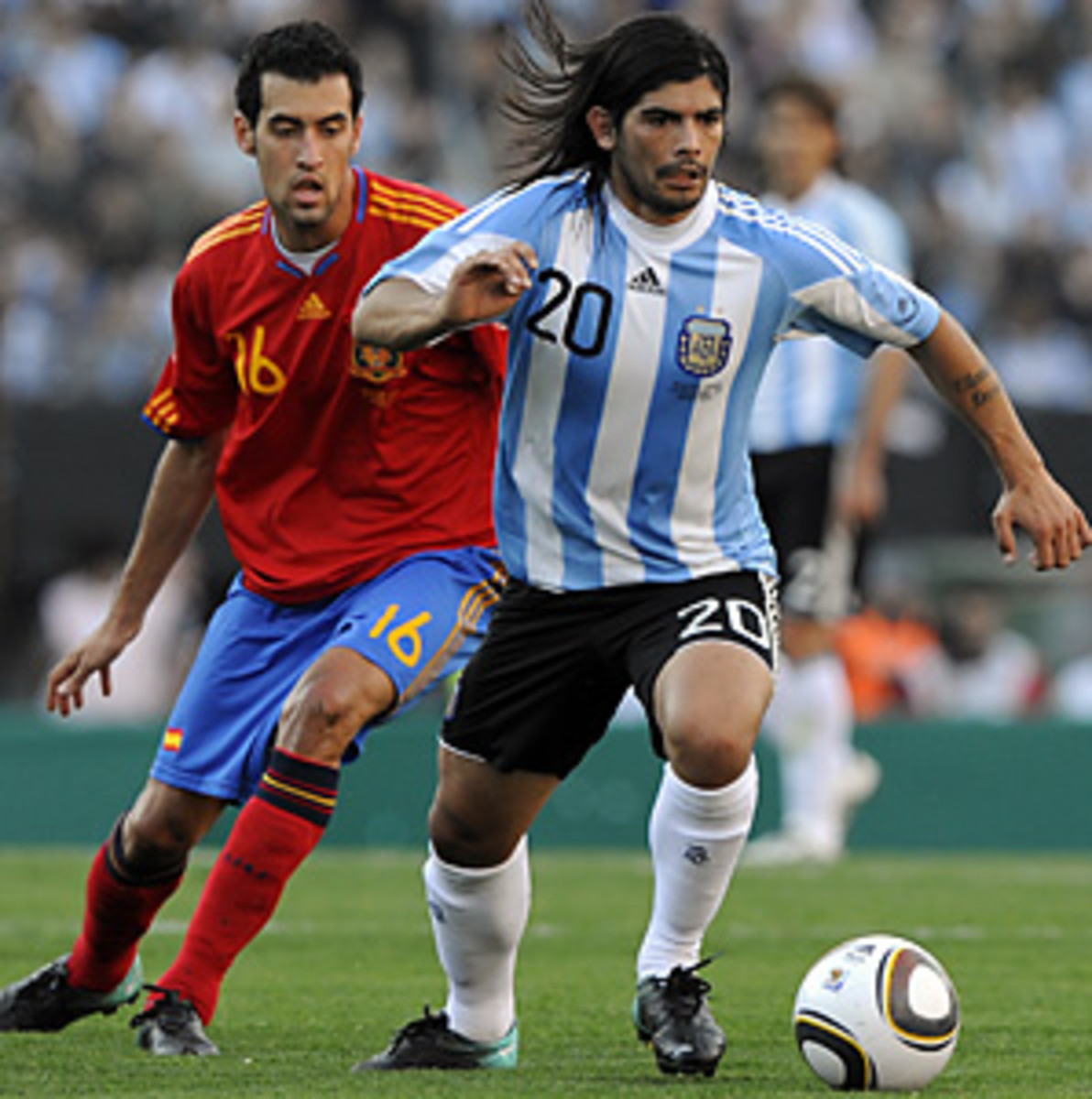
Inclusion of Banega restores balance to Argentina's midfield
Much will be made of the fact that Batista recalled Esteban Cambiasso, controversially left out of the World Cup squad. Perhaps this is missing the point. There was no outcry in Argentina when Maradona dropped Cambiasso in 2008. He had been one of the less effective players in a side that under Alfio Basile had won only one of its seven previous World Cup qualifiers.
Maradona initially based his side around the central midfield axis of Javier Mascherano and Fernando Gago -- the former a better defensive midfielder than Cambiasso, the latter at least as fluid in possession. Later, Juan Sebastian Veron became the king of the midfield, and played well earlier this year when Argentina won 1-0 at Germany -- a match in which the Germans managed only one shot on target in 90 minutes.
Come the World Cup, however, Maradona left Gago at home, fearing that the lack of first-team opportunities at Real Madrid had taken the edge off his game. And during the tournament he decided he could do without Veron -- with ultimately disastrous results in attack and defense.
When they met the Germans once more in the quarterfinal, the Argentines had no balance. They were wide open to the German counterattack, and in the absence of a central midfield, Lionel Messi was forced ever deeper in search of possession.
It is for this reason that, rather than Cambiasso, the key inclusion in the team against Spain was that of Valencia's Ever Banega -- to my mind the most astonishing omission from the World Cup squad.
I well recall the first time I saw the stocky Banega, in Argentina's debut match of the 2007 South American U-20 Championships. Within the first 30 seconds he was in my notebook, having played a pass of extraordinary technical ability. His promise stood out. Within six months he had made his debut with Boca Juniors and won both the Copa Libertadores and the World Youth Cup.
The subsequent three years have not all been smooth sailing. Banega had to grow up in public and had his brushes with wild-child excesses. He moved to Valencia, a club in crisis, floundered for a while, and spent a spell on loan with Atletico Madrid, before maturing and becoming emphatically good last season.
From an Argentina point of view, his most interesting facet is his capacity to combine with Messi -- seen to good effect in the outstanding opening goal the little Barcelona genius scored against the Spanish. This makes Banega a key member of the starting lineup and could also help resolve the long-running controversy surrounding playmaker Juan Roman Riquelme, who had made himself unavailable for selection while Maradona was in charge.
Batista is a huge Riquelme fan, and once he recovers his fitness the Boca Juniors No. 10 will probably be in line for a recall. But Riquelme is 32. He will be 36 during the next World Cup. Reverting to a Riquelme dependence does not appear a viable strategy. Banega is not a direct replacement, for all the range of his passing. But he is more versatile -- for Boca in 2007 he even played as the holding midfielder, no doubt watching and learning from Riquelme's ability to pass his way through opposing defenses. The balance he brings to the side, and his ability to find a wavelength with Messi, makes Banega a big part of Argentina's future.
Sorting that out is the easy part of Batista's job. The hard part comes in reconstructing the defense, where he has problems all along the line.
Right back Javier Zanetti is hugely unfortunate to have missed out on the last two World Cups, and is talking about still being around in 2014. Given the fact that he is 37, this looked unlikely before the kickoff against Spain -- and much more so after substitute Pedro tormented him in the second half.
On the other flank, Gabriel Heinze produced a wonderful cross for Argentina's fourth goal. But even many of his admirers would conclude that the 32-year-old is too slow to be a top-class left back. And age is not on his side -- as is also the case with the side's center backs.
Like Heinze, Martin Demichelis and Gaby Milito have now passed 30. The burly Demichelis has always been vulnerable when quick forwards run at him, but it was Milito who looked especially insecure against the Spanish. He is a defender who can at times look imperious, but veteran Argentina watchers have seen too many times when he has been turned, beaten in the air or struggled for pace. There were examples of all of those against Spain.
Who are the possible replacements? Ezequiel Garay has picked up another injury at Real Madrid. Juan Daniel Forlin endured a difficult first season with Espanol. Nico Otamendi, unwisely used at right back during the World Cup, now has to settle in to new surroundings at Porto. And good young fullbacks are thin on the ground.
The task of building a new defense for Argentina will not be an easy one. Beating the world champion by such a convincing score line makes it likely that Batista will be handed the challenge.




